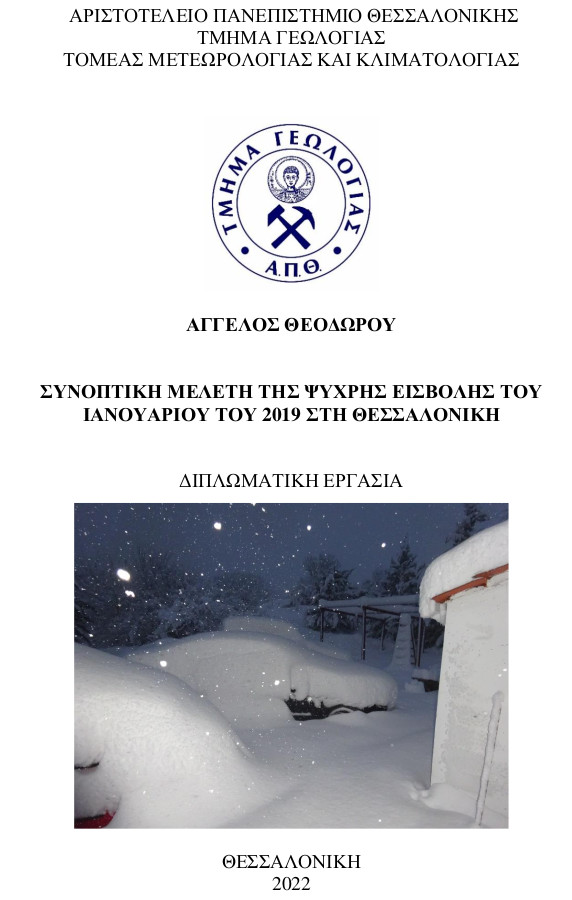
Συνοπτική μελέτη της ψυχρής εισβολής του Ιανουαρίου του 2019 στη Θεσσαλονίκη = Synoptic study of the January 2013 cold invasion in Thessaloniki.
Περίληψη
In this dissertation the case of a cold wave is being studied. It begun from the eastern parts of Scandinavia on January 2nd 2019 and moved towards the region of Greece at high speed, where it remained until January 9th. As a result, severe snowstorms occurred in specific regions of Northern Greece, especially at the Prefecture of Thessaloniki, where in some low altitude flat areas over 50 cm of snow were accumulated. For that reason, this study focuses on this area. Initially, the results of this severe phenomenon are being discussed. Afterwards, an analysis of the synoptic situations of the atmosphere is being made, aiming for a deeper understanding of the causes of this phenomenon. The rise of a high pressure system towards Western and Northern Europe in combination with a trough existing just north - northeast of Greece, seem to be the main reasons for the intrusion of cold air masses in Southeastern Europe. These cold air masses, along with low pressure systems coming from the Ionian Sea, caused snowfalls, mostly in Northern Greece. Lastly, some snowfall related meteorological parameters are being analyzed. These parameters provide an explanation for the increased amount of snow that fell at some parts of the Thessaloniki Prefecture. A convergence line just above the surface, in combination with some geomorphological factors, were responsible for the locally severe snowfalls.
Πλήρες Κείμενο:
PDFΑναφορές
Ahrens, C. D. (1998). Essentials of Meteorology – An Invitation to the Atmosphere, 2nd edition. Wadsworth, Inc.
Anagnostopoulou, C., Tolika, K., Lazoglou, G., & Maheras, P. (2017). The exceptionally cold January of 2017 over the Balkan Peninsula: A climatological and synoptic analysis. Atmosphere, 8(12), 252.
Dafis, S., Lolis, C. J., Houssos, E. E., & Bartzokas, A. (2016). The atmospheric circulation characteristics favouring snowfall in an area with complex relief in Northwestern Greece. International Journal of Climatology, 36(10), 3561-3577.
Grossi, G., Lendvai, A., Peretti, G., & Ranzi, R. (2017). Snow precipitation measured by gauges: Systematic error estimation and data series correction in the central Italian Alps. Water, 9(7), 461.
Lagouvardos, K., & Kotroni, V. (2002). The 4–6 January 2002 heavy snowfall over Central and Southern Greece: assessment of MM5 model forecasts. In Proceedings of the 4th EGS plinius conference, Mallorca, Spain.
Louka, P., Boucouvala, D., Gofa, F., Balami, M., & Ziakopoulos, D. (2010). Operational forecasting of a snowfall event over the Greater Athens Area. Advances in Geosciences, 23, 25-30.
Prezerakos, N. G., & Angouridakis, V. E. (1984). Synoptic consideration of snowfall in Athens. Journal of climatology, 4(3), 269-285.
Prezerakos, N. G. (1990). Synoptic flow patterns leading to the generation of north‐west African depressions. International Journal of Climatology, 10(1), 33-48.
Sahsamanoglou, H. S. (1989). Summer snowfalls over the mount Olympus area. International Journal of Climatology, 9(3), 309-319.
Trigo, I. F., Davies, T. D., & Bigg, G. R. (1999). Objective climatology of cyclones in the Mediterranean region. Journal of climate, 12(6), 1685-1696.
Trigo, I. F., Bigg, G. R., & Davies, T. D. (2002). Climatology of cyclogenesis mechanisms in the Mediterranean. Monthly Weather Review, 130(3), 549-569.
Βάρφη, Μ. Σ. (2009). Συνοπτική και δυναμική μελέτη των θερμών και ψυχρών εισβολών στον ευρύτερο ελλαδικό χώρο (No. GRI-2010-4367). Διδακτορική διατριβή. Τμήμα Γεωλογίας. Αριστοτέλειο Πανεπιστήμιο Θεσσαλονίκης.
Εθνική Μετεωρολογική Υπηρεσία (2021). Χιονοπτώσεις στην Αττική 15-17 Φεβρουαρίου 2021 – Κλιματικά Στοιχεία (http://www.emy.gr/emy/el/pdf/snowfall15-17Feb2021.pdf).
Γιαννουλάκης, Ι. Β. (2014). Συνοπτική και δυναμική μελέτη του φαινομένου της χιονόπτωσης στη Θεσσαλονίκη (No. GRI-2015-13601). Μεταπτυχιακή διπλωματική εργασία. Τμήμα Γεωλογίας. Αριστοτέλειο Πανεπιστήμιο Θεσσαλονίκης.
Κυριαζόπουλος Β., (1948). Το χιόνι στην Ελλάδα. Ανάτυπο από το «Βουνό» του Ελληνικού Ορειβατικού Συνδέσμου.
Λιβαδάς Γ., (1955). Περί των συνθηκών ομάδων ημερών απότομου μειώσεως της θερμοκρασίας εν Ελλάδι, Διατριβή επί διδακτορία, Θεσσαλονίκη.
Λιβαδάς, Γ. Κ., & Στεργίου, Α. (1975). Snow in Thessaloniki= Το χιόνι στη Θεσσαλονίκη. Επιστημονική Επετηρίς: εκδιδόμενη υπό της Σχολής των Φυσικών και Μαθηματικών Επιστημών (ΑΠΘ), 15(2), 265-275.
Μακρογιάννης Τ. Ι. και Σαχσαμάνογλου, Χ. Σ., (2004): Μαθήματα Γενικής Μετεωρολογίας. Εκδόσεις ΧΑΡΙΣ Θεσσαλονίκη, 414 σελ.
Μαχαίρας, Π., & Μπαλαφούτης, Χ. (1985). Μαθήματα Γενικής Κλιματολογίας με στοιχεία Βιοκλιματολογίας
Φλόκας Α., (1997): Μαθήματα Μετεωρολογίας και Κλιματολογίας. Εκδόσεις ΖΗΤΗ Θεσσαλονίκη, 465 σελ.
ΙΣΤΟΣΤΕΛΙΔΕΣ
http://weather.uwyo.edu/upperair/sounding.html
http://www2.wetter3.de/Archiv/archiv_dwd.html
https://data.giss.nasa.gov/gistemp/maps/
https://glossary.ametsoc.org/wiki/Level_of_nondivergence
https://madis-data.ncep.noaa.gov/snow_measurements.html
https://meteosearch.meteo.gr/
https://northmeteo.gr/
https://wvs.earthdata.nasa.gov/
https://www.johndcook.com/interpolator.html
https://www.metoffice.gov.uk/weather/learn-about/weather/types-of-weather/clouds/other-clouds/convergence-lines
https://www.ogimet.com/metars.phtml.en
https://www.weather.gov/source/zhu/ZHU_Training_Page/Miscellaneous/Heights_Thicknesses/thickness_temperature.htm
https://zoz.cbk.waw.pl/snieg/en/index.html
Εισερχόμενη Αναφορά
- Δεν υπάρχουν προς το παρόν εισερχόμενες αναφορές.
